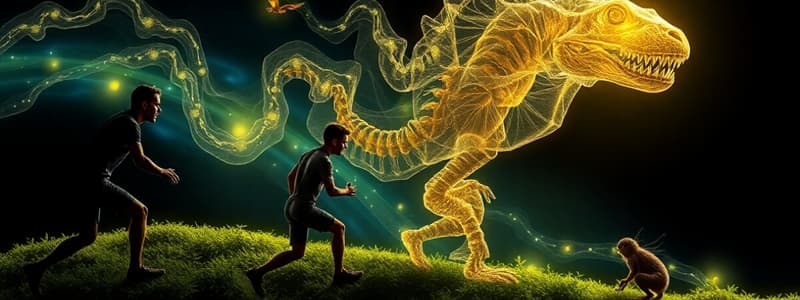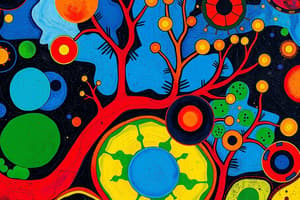Podcast
Questions and Answers
Which of the following kingdoms is characterized by multicellular organisms that can be either autotrophic or heterotrophic?
Which of the following kingdoms is characterized by multicellular organisms that can be either autotrophic or heterotrophic?
- Protists (correct)
- Animals
- Fungi
- Plants
All animals fall into one of nine different phyla.
All animals fall into one of nine different phyla.
True (A)
What is the digestive feature of flatworms in phylum Platyhelminthes?
What is the digestive feature of flatworms in phylum Platyhelminthes?
They have a digestive cavity with only one opening.
The two main types of symmetry found in animals are _____ and _____.
The two main types of symmetry found in animals are _____ and _____.
Match the following phyla with their characteristics:
Match the following phyla with their characteristics:
Which of the following is the largest order of mammals?
Which of the following is the largest order of mammals?
Bryophytes have a vascular system.
Bryophytes have a vascular system.
Name one example of a pteridophyte.
Name one example of a pteridophyte.
The animal classification level immediately above family is called ______.
The animal classification level immediately above family is called ______.
Match the following groups to their characteristics:
Match the following groups to their characteristics:
Which statement describes bryophytes?
Which statement describes bryophytes?
Mosses are considered a type of pteridophyte.
Mosses are considered a type of pteridophyte.
What two tissues are present in pteridophytes?
What two tissues are present in pteridophytes?
Which phylum includes organisms that have radial symmetry and stinging cells?
Which phylum includes organisms that have radial symmetry and stinging cells?
Earthworms have a closed circulatory system.
Earthworms have a closed circulatory system.
What is the primary reproductive method of sponges?
What is the primary reproductive method of sponges?
The respiratory process in segmented worms like earthworms occurs through their __________.
The respiratory process in segmented worms like earthworms occurs through their __________.
Match the following characteristics to their respective phyla:
Match the following characteristics to their respective phyla:
Which class within the phylum Mammalia includes animals such as wolves and bears?
Which class within the phylum Mammalia includes animals such as wolves and bears?
All members of the phylum Mollusca possess a mantle that secretes a shell.
All members of the phylum Mollusca possess a mantle that secretes a shell.
What term describes the body plan of organisms that have a tube within a tube digestive system?
What term describes the body plan of organisms that have a tube within a tube digestive system?
Flashcards
Protista Kingdom
Protista Kingdom
A kingdom of single-celled or multicellular eukaryotic organisms that are not plants, animals, or fungi. They can be either heterotrophic (consuming other organisms) or autotrophic (producing their own food).
Fungi Kingdom
Fungi Kingdom
A kingdom of heterotrophic organisms that digest food externally using exoenzymes. They can be saprophytic (feeding on dead things), parasitic (feeding on living things), or symbiotic (living in a relationship where both benefit).
Platyhelminthes (flatworms)
Platyhelminthes (flatworms)
A phylum of invertebrates with bilateral symmetry and a digestive system with only one opening. Examples include flukes and tapeworms.
Nematoda (roundworms)
Nematoda (roundworms)
Signup and view all the flashcards
Animal Phyla
Animal Phyla
Signup and view all the flashcards
Rodentia Order
Rodentia Order
Signup and view all the flashcards
Bryophytes
Bryophytes
Signup and view all the flashcards
Pteridophytes
Pteridophytes
Signup and view all the flashcards
Vascular Tissue
Vascular Tissue
Signup and view all the flashcards
Domain Eukarya
Domain Eukarya
Signup and view all the flashcards
Kingdom Animalia
Kingdom Animalia
Signup and view all the flashcards
Plant Kingdom
Plant Kingdom
Signup and view all the flashcards
Species
Species
Signup and view all the flashcards
Annelida
Annelida
Signup and view all the flashcards
Porifera
Porifera
Signup and view all the flashcards
Mollusca
Mollusca
Signup and view all the flashcards
Coelenterates/Cnidarians
Coelenterates/Cnidarians
Signup and view all the flashcards
Echinodermata
Echinodermata
Signup and view all the flashcards
Chordata (vertebrates)
Chordata (vertebrates)
Signup and view all the flashcards
Carnivora
Carnivora
Signup and view all the flashcards
Primate
Primate
Signup and view all the flashcards
Study Notes
Characteristics of Living Organisms
- Living things exhibit seven key characteristics: growth and development, nutrition, sensitivity, movement, reproduction, excretion, and respiration.
Living vs. Non-living Things
- Living things (people, animals, and plants) are categorized into different groups, while non-living things (natural and man-made) are separate.
Creation vs. Evolution
- This topic examines opposing viewpoints on the origin of life, discussing the Genesis creation story and the Big Bang theory alongside Charles Darwin's evolutionary ideas.
Primordial Soup
- A cartoon illustrates the idea of life arising from simple organic molecules in early Earth's oceans. This concept forms one perspective about the origins of life.
Charles Darwin
- Images depict Charles Darwin's theories about evolution, illustrating the idea of gradual change over time.
Characteristics of Life (7)
- Growth and development: Increase in cell size and/or number.
- Nutrition: Intake of food for energy and growth; plants make their own food, animals get theirs from plants or other animals.
- Sensitivity: Response to stimuli either inside or outside the organism.
- Movement: The organism or parts of it move.
- Reproduction: Producing offspring.
- Excretion: Eliminating waste products.
- Respiration: Using food to generate energy.
MRS GREN
- A mnemonic device (MRS GREN) helps remember the seven characteristics of life: Movement, Respiration, Sensitivity, Growth, Reproduction, Excretory functions, and Nutrition.
Dead or Alive
- This section differentiates between living things and inanimate objects.
Homeostasis in Humans
- In this section, discussions cover the processes of maintaining a balanced internal environment.
Animal Classification
- Taxonomy: The science of naming and classifying organisms.
- Binomial nomenclature: System of naming organisms using two names (Genus species). The scientist Carl Linnaeus formalized this approach.
Domains and Kingdoms
- A diagram illustrating the hierarchical classification of organisms from domains (Bacteria, Archaea, Eukarya) to kingdoms (like animals, plants, fungi, protists).
Phylum Animalia
- 35 smaller groups (phyla) of animals—classified as vertebrates (with backbones) or invertebrates (lacking backbones).
- Key phyla include Coelenterata, Chordata, Arthropods, Mollusks, and Echinoderms.
Types of Symmetry
- Bilateral symmetry: An organism can be divided into mirror images along only one line (e.g. beetle).
- Radial symmetry: An organism can be divided into multiple mirror images around a central axis (e.g. coral polyp).
- No Symmetry: An organism has no lines of symmetry (e.g. sponge).
Phylum - Protista
- Divided into two subgroups: Protists are single-celled organisms (like protozoa), and multicellular algae.
- Single-celled like Amoeba, Paramecium, and Euglena.
Phylum - Fungi
- Heterotrophic organisms that digest food externally. They secrete exoenzymes to digest food.
Classification of Animals
- Animals are grouped into vertebrates (with backbones) and invertebrates (without backbones).
Classification of Plants
- The hierarchical classification of plants, emphasizing different plant groups, such as non-vascular, vascular, plants with seeds, and seedless plants.
- Categories include: Bryophytes, Pteridophytes, Gymnosperms, and Angiosperms.
- Examples of flowering and non-flowering plants are included
Structure and Function in Simple Plants
- Thallophyta (Algae) are simple plants, meaning they lack well-defined roots, stems, and leaves.
- Thallophyta are mostly aquatic plants.
Cellular Respiration
- Aerobic respiration (efficient): Requires oxygen, occurs in eukaryotic cells, and produces large quantities of ATP (cellular energy)
- Anaerobic respiration (inefficient): Does not require oxygen, also occurs in specific prokaryotic cells and some eukaryotes (like muscle cells under periods of high demand).
- Specific processes and locations are detailed in the diagrams.
Cell Structure
- Various organelles within eukaryotic cells (including those from plant and animal origins ) are discussed, including their function.
Relative Sizes
- Diagrams illustrate the relative sizes of various biological entities, starting from atomic scales to macroscopic organisms.
Studying That Suits You
Use AI to generate personalized quizzes and flashcards to suit your learning preferences.




